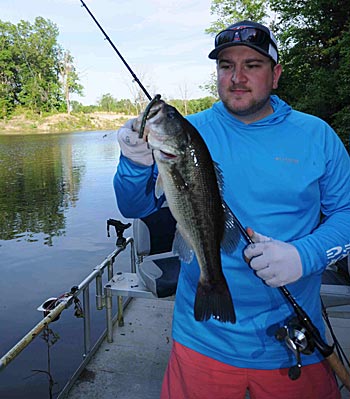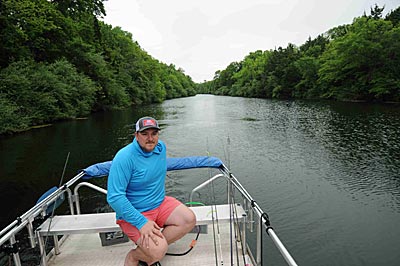
Strip mining that has scarred the Earth’s surface has become beauty marks for bass anglers.
Strip mining is a process of removing the surface soil and rock overlying a mineral deposit. Some of the open pits left after the minerals were removed eventually filled with water and turned into bass fishing havens.
I recently got a chance to fish some of these strip pits near Clinton, Mo., with my cousin Ryan Miloshewski. My strip-pit fishing experience includes a writers’ outing with Ambush Lures at some of the pits around Clinton and a trip to a strip pit lake in Illinois when I was a kid.
Most strip pits are private, so the waters receive very little fishing pressure, and the bass tend to be more aggressive than their cousins in public lakes. The pits I have fished are mainly straight narrow bodies of water with steep banks except for a few shallow ends where the mining equipment had access to the pits. In some pits, the water was so narrow we could stay in the middle and cast to the banks on either side of the pit.
During my most recent trip to the strip pits, we spent about half of our two-day trip fishing for big bluegill, redear sunfish, and crappie so I could stock up my photo files for stories on those species. We spent the first evening of our trip and the next morning concentrating on bass, but our second day was cut short by the threat of severe storms that hit the area.
The first pit we fished was T-shaped with shallow water at the end of each part of the “T”. The water was clear enough for sight fishing, but we saw no bass on beds. The second pit had experienced more rain runoff recently, and the water was stained. I was concentrating on catching a big bass for photos at the stained water pit, so I pitched a black/chartreuse flipping tube to wood cover. I kept getting bites and missing fish, which led me to believe the bass were picking up the bait and moving it off a bed.
Frustrated by all my swings and misses, I decided to scale down my bait and switched to a lure touring pro Tim Horton rigged for me with a weight inserted in the tail of Texas-rigged Yum Dinger. The move paid off for me as I pitched the lure to a flooded bush and immediately caught a 17-inch largemouth.
That evening Ryan caught a 15-inch bass on a wacky-rigged fluorescent green floating worm, and we probably caught about 20 fish, mainly around 12 inches long, in the couple of hours we concentrated on bass fishing. My most productive lures that evening were a shaky head beaver-style bait and a Berkley Bullet Pop topwater lure.

The following day was cloudy, so we decided to fish the pit with the clearer water and caught bass on a variety of lures. The wacky-rigged floating worm produced several small bass early in the morning. Guessing bass were suspended along the steeper banks later in the morning, I switched to a Fluke-style bait and caught several 12-inch or shorter bass. I also tricked several suspending bass with a Larew 6-inch Sinking Slugger, a soft plastic lure similar in design to the original Lunker City Slug-Go.
When we reached the weed-filled shallows at the far end of the pit, we started throwing hollow-belly frogs across the weed mats. We had a few blowups in the mats, but our best action was in the open holes and edges of the weeds, where the bass cruised more in the open due to the cloud cover.
Although we never caught a bass heavier than 3 pounds from the pits, we caught numerous 12-inch largemouth, and I got the chance to test some lures I had never tried before successfully.
Even though strip pits are loaded with bass and receive little fishing pressure, strip pit bass still get moody when weather and water conditions are unfavorable. On our recent trip to the pits, we encountered bluebird skies and 35-mph winds the first afternoon, which made the fishing tough. During our writers’ trip several years ago, runoff from rains earlier in the week had turned the water off-colored in the pits, and a cold front had dropped the temperature into the 40-degree range. Despite the unfavorable conditions, I still caught 25 bass, with the largest weighing about 3 1/2 pounds. That is usually considered a slow day, though, because strip pit anglers I know have said the pits can yield 40 to 50 bass a day with a chance to catch multiple bass in the 5- to 8-pound range.
Strip pits also give anglers a chance to fish without having to own a high-priced bass boat. We fished from two-man plastic boats on our writer’s trip, and Ryan and I fished from small pontoon boats powered by trolling motors that the property owners allowed us to use. Rowboats, canoes, and kayaks are also suitable crafts for fishing the pits.
Gaining access to a strip pit is probably the most challenging part of fishing the pits. The key is getting permission to fish on the property and developing a good relationship with the landowner to ensure return trips to these private waters.
BassResource may receive a portion of revenues if you make a purchase using a link above.




